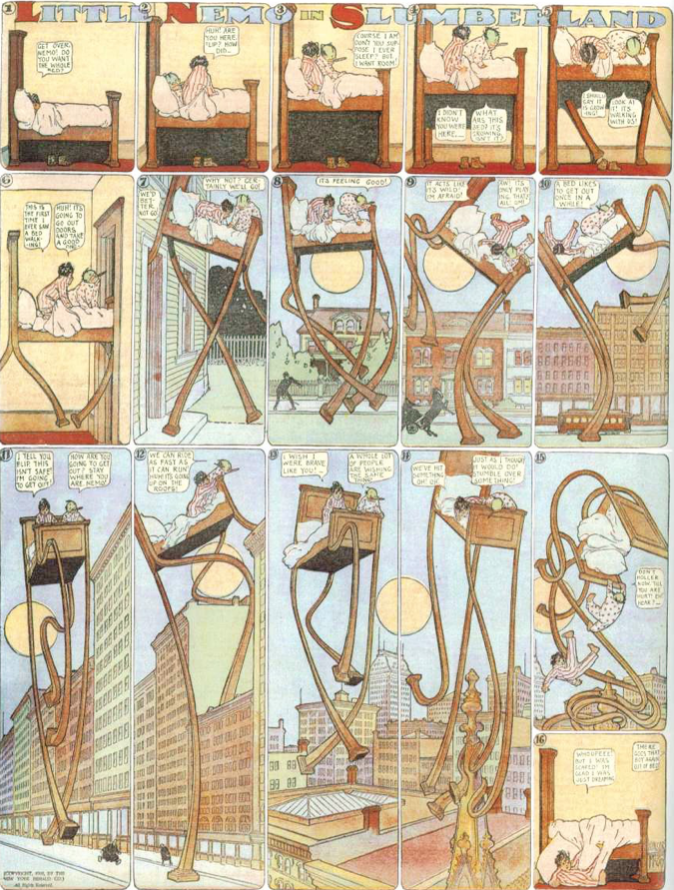Framing Dreams and the Technological Uncanny (Part One)
/This is the third in a series of posts showcasing outstanding work of students who participated in my PhD seminar in the fall focused on theories and histories of the debates around medium specificity. Mina Kaneko is a PhD candidate in Comparative Media and Culture (in the Comparative Studies in Literature and Culture program) at USC. She works on contemporary Japanese and Anglophone comics, literature, and cinema.
Framing Dreams and the Technological Uncanny
by Mina Kaneko
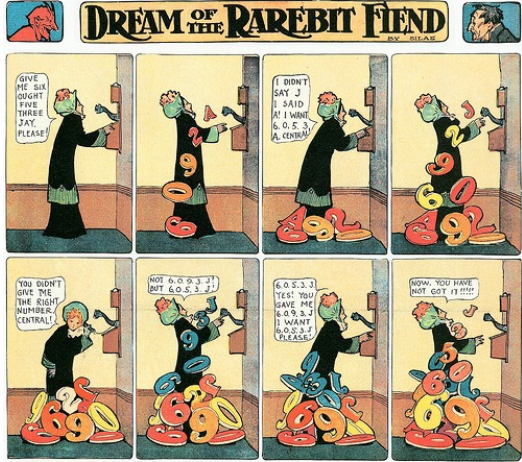 From Dream of the Rarebit Fiend, by Winsor McCay.
From Dream of the Rarebit Fiend, by Winsor McCay.
In his essay "Re-newing Old Technologies," Tom Gunning writes about the extreme pleasures and anxieties we feel when we encounter new technologies, which present us not only with "convenient devices," but transform the ways we perceive and interact with the world (51). At the same time, inevitably, we grow used to them, adjusting our habits to accommodate them into our lives until they become everyday banalities. Gunning uses Wolfgang Schivelbusch's analysis of the railway as an example of this interaction between novelty and habituation, describing how early train commuters were both consumed by “a gnawing fear of death through accident” and thrilled by the "novelty of traversing space at un-heard of speeds" (46). Such strong reactions seemed to subside when new cultural practices were introduced—reading on the train, for example—and train travel became second nature. However, Schivelbusch and Gunning suggest that those initial feelings of awe and fear were "camouflaged but not eliminated," and buried deep into the unconscious (46). The moment the train breaks down, or any other such trigger, the "repressed material returns with a vengeance"—a phenomenon Gunning, evoking Freud, calls "the technological uncanny."
Schivelbusch's example may be about Western urbanization and industrialization at the turn of the twentieth century, but Gunning points out that it resonates today in our so-called Information Age, in which we've seen a similar proliferation of new technologies; he writes that "the two ends of the Twentieth Century hail each other like long lost twins" (51). With this in mind, I've decided to look at two bodies of work that allude in some way to the idea of the "technological uncanny": the first being Winsor McCay's comic strips Dream of the Rarebit Fiend (1904-1913) and Little Nemo in Slumberland (1905-1914), and the second Satoshi Kon's anime Paprika (2006). Though each is distinctive, they seem to be in conversation with one another in interesting ways (many thanks to Henry for giving me the idea to compare the two side by side!)—if not as twins, then perhaps as cousins, from opposite ends of the century and from across the globe (U.S. and Japan, respectively).
These works use the subject of dreams as a space to explore fascinations and horrors about technologically advancing societies while also self-consciously reflecting on their own processes of mediation. In them, comics and anime seem to offer a symbolic language apt for representing fantastical, surreal worlds and helps provide critical distance by which to think about technological change. What's particularly striking is that both McCay and Kon share a preoccupation with the "frame" (as in the comics frame, or the frame of the screen), which they frequently play with to call attention to mediation. First, I'll take a look at McCay's work, in which the frame is used to contain and order dreams in which anxieties about technology appear, and which he often deconstructs as a tool for reflexivity. Then, I'll look at Kon's Paprika, in which dreams are a kind of metaphor for media itself; the film uses ideas of "immediacy" and "the frame" as tropes to express ambivalence about a media-saturated world. While there are a number of subjects I'd like to explore further—such as the cultural contexts and time periods in which these texts are born—this is an early draft and the beginnings of a larger project I hope to develop. I'll start primarily with a close-reading of the texts themselves to begin to speculate about some of the connections between dreams, comics, anime, and technology.
Winsor McCay's Dream of the Rarebit Fiend & Little Nemo in Slumberland
Let's start by looking at Dream of the Rarebit Fiend, which appears to allude directly to the idea of the technological uncanny described by Gunning. Rarebit Fiend was a weekly comic strip first published in 1904 in the New York Evening Telegram, a kind of evening counter-part to the New York Herald. After that, in 1911, McCay moved to media company Hearst, where he published an adaptation in the New York American before returning to the Herald in 1913, when Rarebit Fiend had a brief revival. While the subject of the strip changed from week to week, it had one recurring theme: someone eats a Welsh rarebit before bed, and consequently has an outrageous dream. Often, these dreams are terrifying and bizarre, reflecting the dreamer’s anxieties—in the last panel, the dreamer consistently awakes, blaming their indulgent bedtime snack for their fitful sleep.
 Cover of the Dover edition of collected Rarebit Fiend comics, depicting a man trapped in cheese.
Cover of the Dover edition of collected Rarebit Fiend comics, depicting a man trapped in cheese.
As several scholars have noted, many of the dreams in Rarebit Fiend reflect the stresses of an increasingly industrialized and overworked society. In Poetics of Slumberland: Animated Spirits and the Animating Spirit, Scott Bukatman says the strip is about a middle-class “queasiness about the modern world” (51). Similarly, Katherine Roeder, in her book Wide Awake in Slumberland: Fantasy, Mass Culture, and Modernism in the Art of Winsor McCay, writes that the strip “investigated the impact of modern life on the individual psyche,”focusing in particular “on the nervous strain caused by the intense stimulation of the metropolis,” and the “increasing threat of bodily peril caused by newer, faster, and more dangerous forms of transportation” (161-162). Indeed, while some strips are more whimsical and less direct in their concerns (in one, a woman is eaten by her alligator purse, which has turned into an actual alligator; in another, a woman ponders the mysterious ingredients of “hot dogs” and is subsequently chased by a pack of dogs) the “nervous strain” brought about by urban life and the “threat of bodily peril” by new modes of transportation figure prominently in the weekly strip. Automobiles and trains are frequently out of control, inciting death or at least, severing limbs; new medicines are excessively effective as to become ineffective, as is the case with a hair-growth elixir that causes a bald man to become a mass of fur and the subject of a public spectacle; bodies are rife with ailments both physical and emotional, as seemingly small injuries (a corn on the foot, uneven leg lengths) stretch and overwhelm to the point of incapacitation. As Bukatman notes, “for the rarebit dreamers…sleep offers no respite from the day’s demands; they can only struggle on” (57).
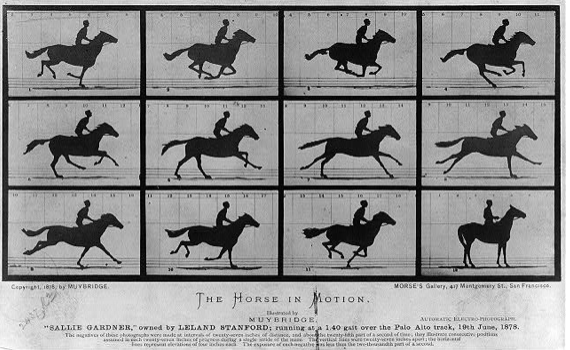 Muybridge's The Horse in Motion, 1878
. Source: Library of Congress
Muybridge's The Horse in Motion, 1878
. Source: Library of Congress
In these comics, McCay often relies on a “fixed perspective” and a generally uniform frame size, which Bukatman says recalls chronophotography like that of Eadward Muybridge in the late 1800s (50). He also suggests that the ordered, repeated, sequential framing evokes the “mechanization of the Fordist assembly line”—a uniformity McCay “resists” by “replacing orderly process with a comedic progression toward chaos and/or death” (Bukatman 23). In other words, McCay uses the evenly spaced time intervals represented by the consistent boxes to map the sequential progress of chaos (or devolvement), something that is further accentuated by the static point of view—thus, we witness clearly “the change that occurs from one panel to the next, as objects and people variously grow and shrink, morph and transmogrify” (Bukatman 50).
For example, in one strip from June 28, 1905, a rarebit dreamer drives with friends, and discovers that all four car tires have deflated; seeking another friend’s help, they replace the tire rubber with cheesy rarebits (fig. 1).
 Fig. 1. From Dream of the Rarebit Fiend by Winsor McCay.
Fig. 1. From Dream of the Rarebit Fiend by Winsor McCay.
As they journey onward, their car spins increasingly out of control, as the cheese in the tires lose their shape, frame by frame. The size of each panel is consistent, marking regular intervals of the cars progression towards breakdown, a “gradual, if accelerating, metamorphosis” (Bukatman 62). Furthermore, because we view the car from a fixed side-view, we witness the radically “transmogrifying” cheese, which becomes an amorphous and stringy mess that overtakes the penultimate panel; the commuters scream, “Help! Save us! Oh, save us! Help! Oh!” The juxtaposition of the ordered, “Fordist” nature of the frame and the surreal invasion of the cheese represents “orderly process” being replaced with “a comedic progression toward chaos.”
In a more gruesome encounter with transportation from October 26, 1904, an elderly man tries to cross Broadway (fig. 2).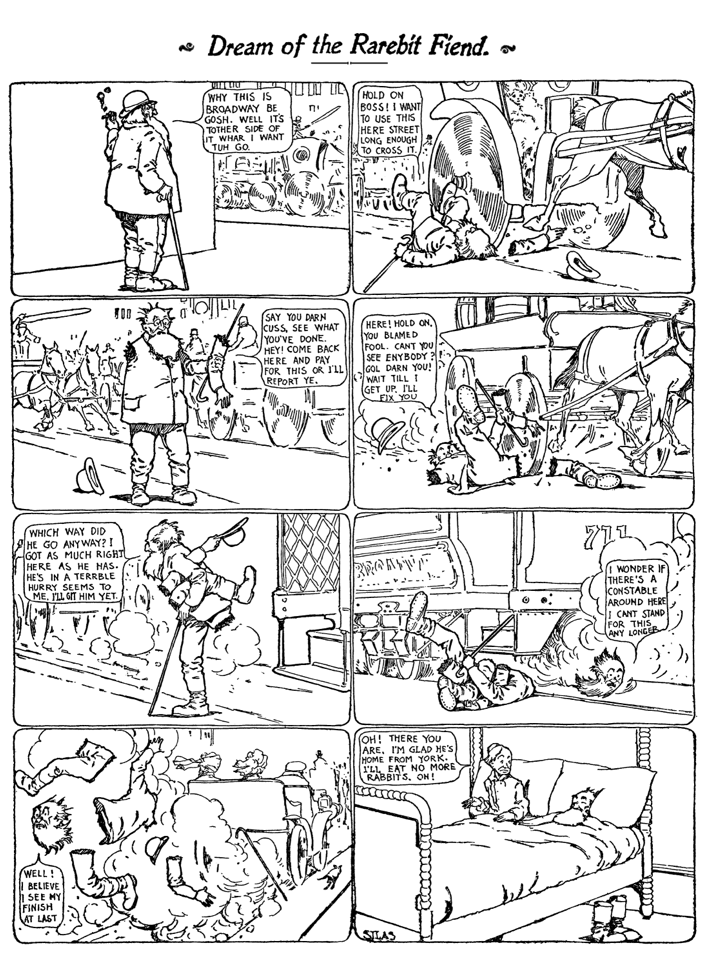 Fig. 2. From Dream of the Rarebit Fiend by Winsor McCay.
Fig. 2. From Dream of the Rarebit Fiend by Winsor McCay.
He is first run over by a horse-drawn carriage, losing his arm; then, he is run over by a water wagon, a trolley, and finally, an automobile, each time severing another part of his body. In the final panel, we see that this is an anxiety dream of the man’s wife, who says to her sleeping husband beside her, “Oh! There you are. I’m glad he’s home from New York. I’ll eat no more rabbits, Oh!” Like the previous strip above, this narrative utilizes the uniform grid to map a “progression towards death,” juxtaposing its chaos within the “orderly process” that confines it. Each frame captures a different moment of the man’s mutilation, which we view from the side of the road where he stands. At the same time, this comic maps a sequence of technological advancements in transportation: the horse-drawn carriage, the water wagon, the trolley, and the automobile, an order which Roeder says is intentional and serves as a kind of “mini-history” of urban transit (175). Thus, the frames also serve to show a historical progression, with each new mode of transportation contributing more and more to the demise of the dream’s poor protagonist.
The lack of movement in the frames seems to symbolize the way the dreams in Rarebit Fiend are grounded in the mundane, for the chaos that ensues takes place in everyday settings. As Bukatman notes, in contrast to Little Nemo, there is “no ‘consistent unreal world,’ no Slumberland on the other side of the journey, no place but the place of the quotidian, newly deformed” (Bukatman 60). Indeed, as we see in the strips above, many of the dreams occur in worlds that seem to mirror the dreamers’ reality, with the fantastical and surreal imposed onto the real. There is no “consistent unreal world” of marvelous characters and imaginative dreamscapes—and the comedic tragedies that occur, occur in the most mundane of moments, such as a drive in the city, or crossing Broadway.
Rarebit Fiend evokes the technological uncanny by contrasting these banalities of everyday life with the fantastical visions of peril that emerge only when the sleeper is dreaming. Using the dreaming state as a space in which fears manifest themselves, McCay seems to play with the Freudian concept that understanding dreams is the "royal road to a knowledge of the unconscious activities of the mind" (604). (It should be noted however, that whatever Freudian themes seem to be at play in McCay's work, The Interpretation of Dreams was not translated into English until 1913, and The Uncanny still later, I believe in 1925; from what I know, McCay was likely not to have read or been aware of Freud's work.)
It is in dreams that “gnawing fear[s] of death through accident” appear, “return[ing] with a vengeance” to the sleeping middle-class American worker, showing that such emotions have only been "camouflaged, but not eliminated" in waking life. The dreamers return to the normalcy of consciousness with relief, grateful for the reality in which such fears "lapse[d] into oblivion," and instead bread and cheese are cause for blame (Schivelbusch qtd. in Gunning 46). The juxtaposition of a constant frame and "fixed perspective," which signal the Fordist order and repetition, and the transmogrified embodiments of anxiety depicted within them, visually reinforce the negotiation between novelty (here, primarily terror) and habituation.
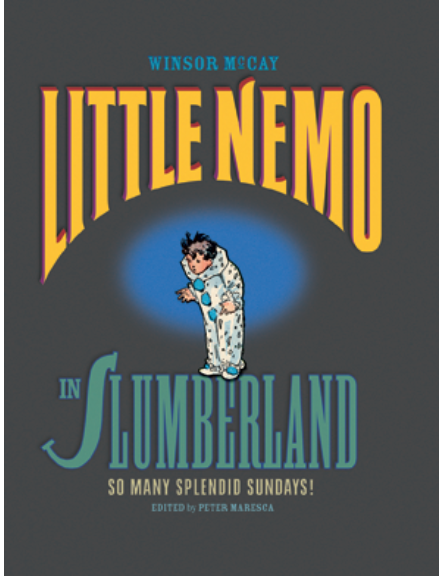 Cover of Little Nemo in Slumberland: So Many Splendid Sundays! Vol. 1 by Sunday Press Books.
Cover of Little Nemo in Slumberland: So Many Splendid Sundays! Vol. 1 by Sunday Press Books.
A similar treatment of anxieties about technology and transportation can be seen in Little Nemo, though the dream world presented is an entirely different one. While initially inspired by Rarebit Fiend, Little Nemo is primarily a departure in that it was designed, in McCay’s words, “to please the little folk” (ix). It too appeared as a weekly comic strip in the New York Herald, but in its Sunday color supplement from 1905-1914, printed on a full-size newspaper sheet that measured approximately 16 by 21 inches (Like Rarebit Fiend, an adaptation was published in the New York American until 1913, and experienced a brief revival in the Herald, from 1924 until 1927). Little Nemo charts the dreams of a young boy as he finds himself in various adventures in enchanted lands; the strip is sometimes fearful, often delightful, and, like Rarebit Fiend, consistently ends with Little Nemo waking to reality.
Unlike the “mundane” spaces of each rarebit dreamer’s lives, Slumberland is presented as fictional realm outside of reality, or a “consistent unreal world,” with recurring characters and developing stories. In this way, Bukatman writes that Little Nemo offers “immersion” rather than “resistance,” in which “the malleability of space, world, and body dominates the strip, investing the solidity of objects with plasmatic possibility” (23). In Rarebit Fiend, elasticity marks the absurd—tires made of uncontrollable cheese, a corn in the foot growing larger than the body—and dramatizes situations of stress in an otherwise “realistic” setting. In Little Nemo, however, it is the dream world itself that is elastic—fluid shapes and vibrant colors create a magical world in which anything is possible, which we view through the eyes of a child. Furthermore, as bed legs stretch and grow (fig. 3), so often do the comic frames containing the image,
Fig. 3. From Little Nemo in Slumberland, by Winsor McCay
giving the impression that the boundaries that cordon off that other world are just as fluid as the land depicted, as though perhaps they could continue to grow large enough for us to step into. The frame that expands and transforms presents itself like a window through which to peer into the other side (a metaphor which articulated by many scholars and a theme that is also taken up in Paprika). Slumberland, like Lewis Carroll's Wonderland, is a place of enchantment and mystery, and McCay invites us to enter (see fig. 4).
Fig. 4. From Little Nemo in Slumberland, by Winsor McCay.
At the same time, however, there remain similar expressions of wariness about the industrial age as those we see in Rarebit Fiend, and they employ a remarkably similar use of the uniform frame as we see in the former. While they may not be cause for gruesome deaths, the automobiles and railways in Little Nemo similarly frequently malfunction or spin out of control. Take this strip from September 6, 1908, in which Nemo’s companion Flip calls upon him to a take a ride in his passenger train (see fig. 5). In the following panels, Flip manages to run through the picket fence lining Nemo’s family’s home, back up straight into a brick building, topple over a horse-drawn carriage, as well as a trolley, and ultimately crashes into a river. In the final panel, Nemo wakes up thrown from his bed onto the floor.
Fig. 5. From Little Nemo in Slumberland, by Winsor McCay.
In a strip from November 29, 1908, Flip causes another such ruckus when he takes Nemo for a ride in his new automobile. Here, Flip shows off his car’s tricks: first by driving up a staircase, then up the side of a tall building, eventually driving back down the building and plunging into a river, again careless of the various objects and monuments he runs over. As he does, Nemo pleads him to stop, saying, “Let’s go back home, Flip, come! This is too dangerous for me!” to which Flip merely brushes him off and encourages him to embrace the adventure. Interestingly, both strips employ the “chronophotographic” model of movement, mapping the progression of chaos by showing the incremental differences contained in the constant frame. It also uses a fixed perspective, consistently positioning the viewer to the side of the car or in front of the approaching train. This is a departure from the elastic windows that stretch and grow with the expanding berries or the moving chair — but rather, reflect the "fixity of the dreamer" and that same Fordist repetition (Bukatman 60). This preoccupation is expressed more explicitly in another strip, where Nemo, Flip, and Imp take “a bath” on Mars; after asking a Martian how one keeps clean on his planet, the three are fed through a “cleaning machine” in which they are flattened by large cleaning rollers that Tim Blackmore, in his essay “McCay’s McChanical Muse,” says resemble the cylinders of the printing press. Flip says, “It’s the first time I was ever dry cleaned like a carpet and the last!” while Nemo exclaims, “Oh! We’re being ironed out like a shirt front Oh! I’m mad now!!!” Nemo and Flip liken themselves to a mass-produced commodity created in a factory, through which they emerge flattened, and are subsequently hung and dried on a clothesline. McCay uses the fictional fantastical world of Nemo—and Mars—to introduce an alien (or alienating) and dehumanizing mechanical process, while visually alluding to the technological mechanism with which the comic itself is mass-produced.
Perhaps one of the most pleasurable, if not most significant, aspects of McCay’s comics lie in such instances of self-reflexivity. In both Rarebit Fiend and Little Nemo, characters will refer to their own existence as a comic strip, or otherwise to the author himself. For example, in one Rarebit Fiend comic, a man dreams he is a “pen and ink drawing,” calling attention to an ink splotch above his right knee—as the comic progresses, he becomes covered in more and more ink stains, and the man continues to comment on the way he is “not drawn carefully.” Similarly, in an episode of Little Nemo from 1909, Nemo and Flip walk through the countryside, which is drawn as a minimalist, black and white line drawing distinctive from the aesthetics of their own bodies—Nemo says, “I’m going home before I change into a bad drawing” (see fig.6). In these, McCay calls direct attention to the “strongly stylized, hand-drawn quality” that Silke Horstkotte says characterizes many cartoons in his essay “Zooming in and Out: Panels, Frames, Sequences.” By introducing different aesthetic styles and explicitly naming “incomplete”
Fig. 6. From Little Nemo in Slumberland, by Winsor McCay.
or “badly drawn” figures, McCay exposes the ways in which these figures are indeed drawn by the subjective hand of a specific artist. Additionally, McCay often experiments with the collapse or breakdown of the frame as a way to direct attention to its own mediation. For example, in another Rarebit Fiend strip, a count attempts to court a young woman, only to be met with rejection; upon discovering she is in love with the cartoonist “Silas” (McCay’s penname for Rarebit Fiend), the man begins to rip apart the comic in which they exist as an act of defiance, until in the end, there is only a pile of “shredded comic” before the dreamer wakes (see fig. 7). Similarly, in a Little Nemo strip from November 8, 1908, Flip invites Nemo into his uncle’s bakery (see fig. 8). As Nemo, Flip, and Imp attempt to take some baked goods, the ink in each pastry begins to disappear, leaving behind the paper beneath it. Slowly, each pastry disappears one by one, until the background is merely the inkless paper; soon the floor disappears, and Flip and Imp fall out of the frame, until only Nemo is left—as Nemo tries to hold on, the frame around him beings to fold, collapsing around him in a heap. He exclaims, “Look what the artist has done to me oh!”
 Fig. 7. From Dream of the Rarebit Fiend, by Winsor McCay.
Fig. 7. From Dream of the Rarebit Fiend, by Winsor McCay.
Fig. 8. From Little Nemo in Slumberland, by Winsor McCay.
As Greg M. Smith points out in “Comics in the Intersecting Histories of the Window, the Frame, and the Panel,” the “frame” in comics is neither bound by a physical frame (in the case of the painting) or by a mechanical apparatus (as in the case of TV or cinema) –rather, it is a hand-drawn construction for organizing a story (231). McCay’s decision to deconstruct the frame further reminds us of his own subjectivity—that the dreams, characters, and objects we see are fictional constructions, where even the window through which we observe them can easily be removed or altered. Such self-reflexivity reminds us of the specific medium with which McCay is working and highlights the way comics themselves require no technological apparatus except pen and paper. In her book Disaster Drawn, Hillary Chute describes drawing and comics as a kind of “counter-inscription” to other highly technologically reliant forms of inscription or mediation, and I think the term particularly apt here. Rather than "emphasizing a story-level similar to the actual world," as Horstkotte says, comics "serv[e] to highlight the discursive qualities of the narrative representation" (33). By collapsing the frame and erasing the characters on which we rely to read his images, we are forced to see the materiality behind that illusory, imaginative world for what it is: Nemo and our dreamers are but ink on paper. At the same time, McCay acknowledges that the newspaper comic strip itself was transformed by the new technology of the rotary presses in the late 1800s that allowed for mass production and distribution; by removing the ink from the Little Nemo strip above, for example, he makes visible the “direct, palpable relationship between the newly mechanized press and the art form of the comic strip” (Blackmore 17). In a time when cinema and photography were popularizing art forms with a certain sensational quality (such as films like the Lumière brothers' 1985 Arrival of a Train that wow'ed viewers with its "closeness" to reality), McCay's use of the medium can indeed be thought of as a kind of counter-inscription to photographic recording of physical, existing objects. While photographs and films are themselves merely representations, comics' discursive qualities dismiss themselves of this evidentiary expectation to begin with. As much as McCay enchants and entices us in some moments, he also frequently deliberately distances us to reveal the construction of his own representations, a reflexivity and call for critical awareness that goes hand-in-hand with the cautionary, if humorous, wariness of technology depicted in his comics.
Works Cited
"Oedipus and the Sphinx " The Met's Heilbrunn Timeline of Art History. N.p., n.d. Web. http://www.metmuseum.org/toah/works-of-art/21.134.1/ Accessed 13 Nov. 2016.
Baudrillard, Jean, and Sheila Faria. Glaser. Simulacra and Simulation. Ann Arbor: U of Michigan, 2014. Print.
Blackmore, Tim. "McCay's McChanical Muse: Engineering Comic-Strip Dreams." The Journal of Popular Culture 32.1 (1998): 15-38.
Booker, Marvin Keith. Comics through Time: A History of Icons, Idols, and Ideas. Santa Barbara, Calif.: Greenwood, 2014, pp 234.
Bolter, Jay David & Richard Grusin. "Remediation." Configurations, vol. 4 no. 3, 1996, pp. 311-358.
Bukatman, Scott. The Poetics of Slumberland: Animated Spirits and the Animating Spirit. Berkeley: U of California, 2012. Print.
Chute, Hillary L. Disaster Drawn Visual Witness, Comics, and Documentary Form. Cambridge: Belknap-Harvard UP, 2016. Print.
Friedberg, Anne. "The Virtual Window." Rethinking Media Change: The Aesthetics of Transition, edited by David Thorburn and Henry Jenkins, MIT Press, 2003, pp. 337-354.
Freud, Sigmund, and James Strachey. The Interpretation of Dreams. New York: Basic, 2010. Print.
Gunning, Tom. “The Art of Succession: Reading, Writing, and Watching Comics.” Comics & Media, edited by Hillary Chute and Patrick Jagoda, University of Chicago Press, 2014, pp. 36-51. - - -. “Re-newing Old Technologies.” Rethinking Media Change: The Aesthetics of Transition, edited by David Thorburn and Henry Jenkins, MIT Press, 2003, pp. 39-60.
Horstkotte, Silke. “Zooming In and Out: Panels, Frames, Sequences, and the Building Of Graphic Storyworlds.” From Comic Strips to Graphic Novels: Contributions to the Theory and History of Graphic Narrative, edited by Daniel Stein and Jan-Noel Thon, Walter de Gruyter, Berlin, 2013. LaMarre, Thomas. The Anime Machine: A Media Theory of Animation. Minneapolis, MN: U of Minnesota, 2009. Print. McCay, Winsor. Dream of the Rarebit Fiend: The Saturdays. West Carrollton, OH: Checker Book Group, 2007. Print. - - -. Dreams of the Rarebit Fiend. N.p.: Dover Publications, 1973. Print. Dover Humor. - - -. Winsor McCay's Little Nemo in Slumberland. Vol. 1. West Carrollton, OH: Checker Book Group, 2007. Print. - - -. Winsor McCay's Little Nemo in Slumberland. Vol. 2. West Carrollton, OH: Checker Book Group, 2007. Print. Ndalianis, Angela. "Architectures of the Senses: Neo-Baroque Entertainment Spectacles." Rethinking Media Change: The Aesthetics of Transition, edited by David Thorburn and Henry Jenkins, MIT Press, 2003, pp. 355-374. Paprika. Dir. Satoshi Kon. By Satoshi Kon, Seishi Minakami, Brian Beacock, Doug Erholtz, and Michael Forest. Sony Pictures Classics, 2007. Roeder, Katherine. Wide Awake in Slumberland: Fantasy, Mass Culture, and Modernism in the Art of Winsor McCay. 1st ed. Mississippi: U of Mississippi, 2014. Print. Great Comics Artists Ser. Smith, Greg M. “Comics in the Intersecting Histories of the Window, the Frame, and the Panel.” From Comic Strips to Graphic Novels: Contributions to the Theory and History of Graphic Narrative, edited by Daniel Stein and Jan-Noel Thon. Walter de Gruyter, 2013, pp. 219-240.
Thorburn, David, and Henry Jenkins. "Introduction: Toward an Aesthetics of Transition." Rethinking Media Change: The Aesthetics of Transition. Cambridge, MA: MIT, 2003, pp. 1-16.
Mina Kaneko is an editor and scholar. She holds a BS in Media, Culture, and Communication from NYU and was formerly Covers Associate at The New Yorker and Editorial Associate at TOON Books. She is currently a PhD candidate in Comparative Media and Culture at USC, where she is a Provost's fellow. Her research interests include contemporary Japanese and Anglophone literature, comics, and cinema, as well as theories of visuality, psychoanalytic theory, and intersections of race, gender, and sexuality.


